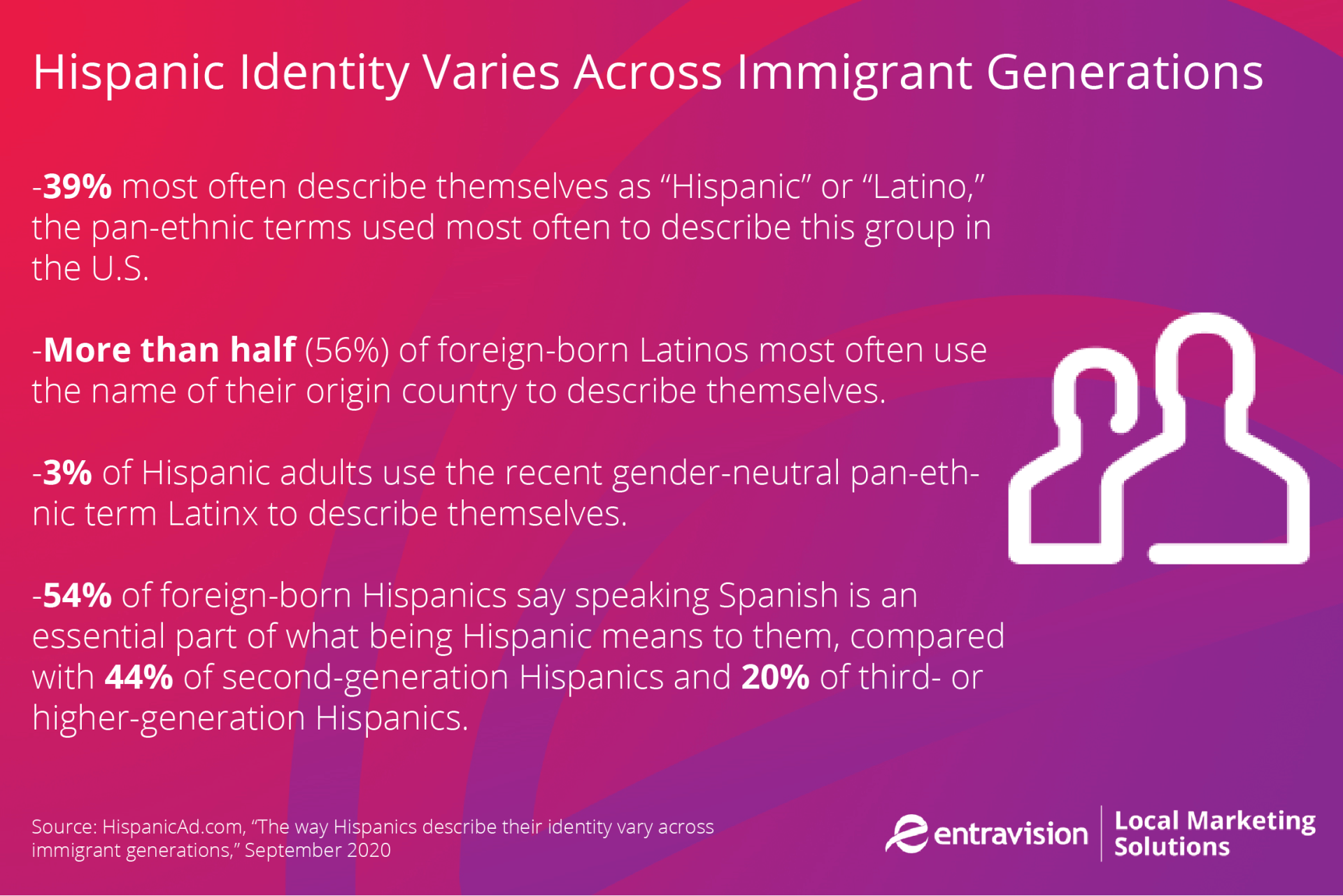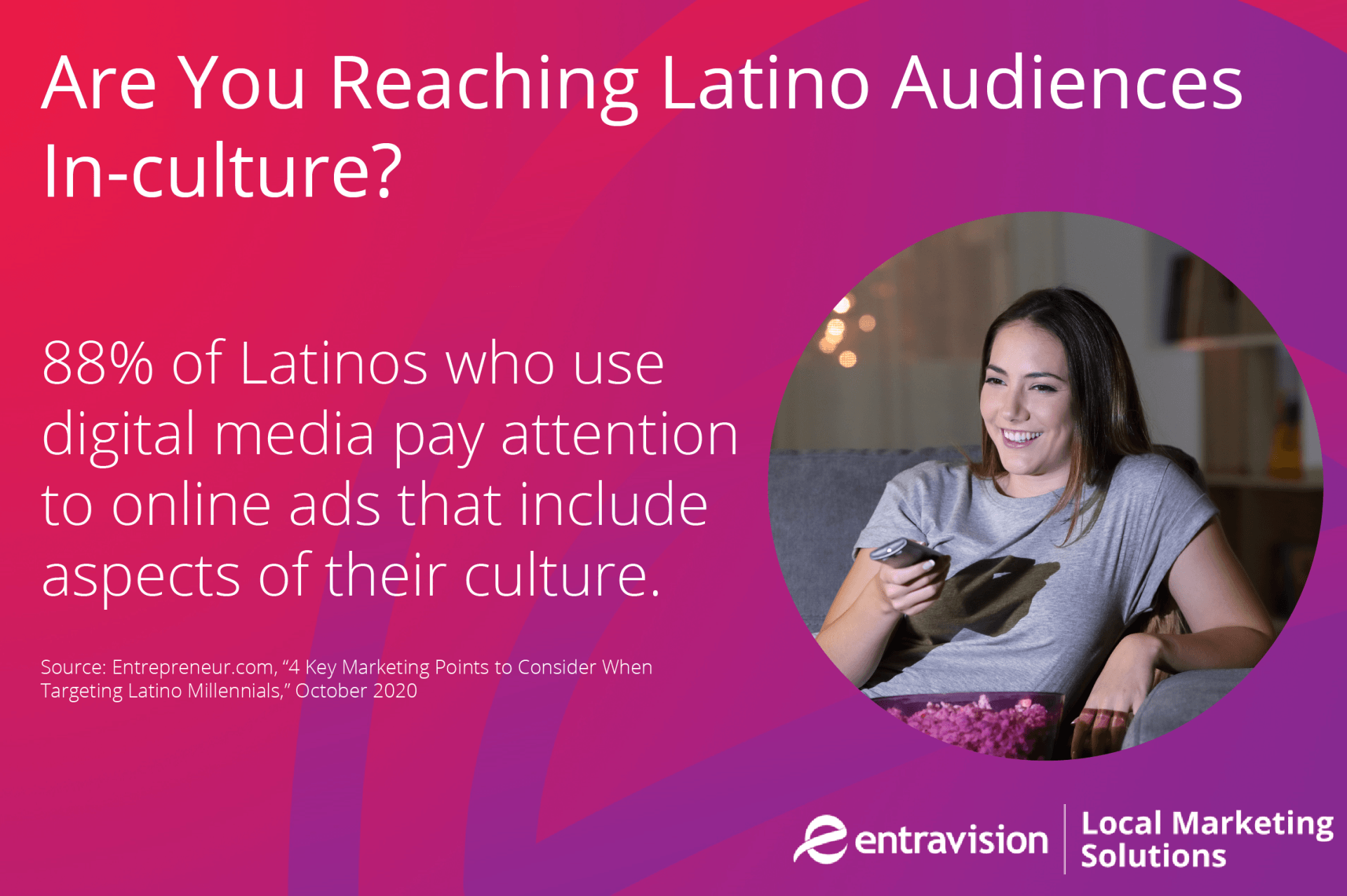How to Market to Latinos Across Immigrant Generations: A Definitive Guide
For Hispanic marketing to be successful, it needs to be as diverse and nuanced as the U.S. Latino population itself. From varied immigrant backgrounds, language preferences, generational differences, and more, effective Hispanic digital marketing strategies make sure to take all of these factors into account. Keep reading for everything you need to know about marketing to Hispanic audiences of all backgrounds - and discover how it can help you grow your business.
Here’s an overview of what we’ll be discussing:
- Understand Hispanic Audiences and Their Language Preferences
- Consider Reaching ELF (English-language First) Hispanics
- Don’t Forget that Country of Origin and Descent Can Play a Major Role, Especially For First Generation Hispanic Immigrants
- Learn How to Reach Each Generation with Digital Marketing
- Recognize the Commonalities: Across Generations, Latinos Appreciate In-culture Advertising
Questions?
Contact us
for more info.
Understand Hispanic Audiences and Their Language Preferences
Before you can even think of what your Hispanic marketing campaign will consist of, it’s crucial to understand your target Hispanic audience’s demographics and language preferences - which often coincides with their immigrant generation status.
For instance, which language should you use to reach them in the first place? According to the Pew Research Center, roughly 38% of Latinos mainly use Spanish, 36% are bilingual, and 25% mainly use English - meaning that the language you use in your marketing campaigns will vary depending on the demographics of your market and target audience.
Get familiar with the various language preference terms below:
- English dominant: A person who primarily uses and communicates in English in their day-to-day life. These individuals usually prefer to be advertised to in English, though there can be exceptions.
- Spanish dominant: A person who primarily uses and communicates in Spanish in their day-to-day life. Spanish-dominant individuals most often prefer ads in Spanish since they are more comfortable and familiar with the Spanish language.
- Bilingual: Bilingual simply means the ability to speak two languages. When it comes to bilingual Hispanic ads, contrary to popular belief, they aren’t necessarily 50/50 English and Spanish. For instance, the ads often utilize Spanglish or have Spanish words sprinkled in. Keep in mind that bilingual individuals can be English or Spanish-dominant, or they may not have a preference.
A quick note about running bilingual ads: Don’t try too hard to be authentic by using Spanglish or slang. Without a thorough understanding and background of your prospective bilingual audience, these ads can run the risk of missing the mark and coming across as stereotypical.
To avoid making faux paus, it’s highly recommended that your business consults with a Hispanic digital marketing agency who are experts in the field. Interested? Feel free to contact one of our marketing consultants or find a location near you. You can also check out our previous article about how to choose a Hispanic digital marketing agency for your local business.
Learn more about marketing to multicultural audiences by watching our video!
Consider Reaching ELF (English-language First) Hispanics
We’re not talking about mythical elf creatures here. In this case, English-language first Hispanics (also known as ELFs) make up over half (55%) of today’s U.S. Hispanic market, which mainly consists of 1.5 and 2.0 generation immigrants. Wondering what this all means? We know it can be a bit confusing, so we’ve got you covered:
- A 1.0 generation immigrant is an immigrant who came to the U.S. when they were 10 years old and up. They typically prefer to consume content in Spanish Language First (SLF) and are culturally much closer aligned to the Hispanic cultural values. Today, they represent roughly 28% of the Hispanic population.
- The 1.5 generation was 10 years or younger when they came to the U.S. They are bilingual and bicultural, and prefer content in English (English Language First, or ELF for short).
- The 2.0 generation is born in the U.S., with at least one immigrant parent. Like the 1.5 generation Latino, they are bilingual and bicultural, preferring to consume English-language content.
- The 3.0 generation is U.S. born with at least one parent who is a second generation. Latinos who are third generation and up represent about 17% of the U.S. Hispanic population.
These definitions are a rule of thumb, however, whether an individual leans more bicultural or more American (English/English only and/or U.S. assimilated) will depend on the specific area they grew up in. For instance, Latinos born and raised in Hispanic-dominant or prevalent areas are more likely to adopt a bicultural identity with stronger cultural ties.
Why does marketing to bicultural ELF Latinos matter? Essentially, this group holds double the influence - both among their Hispanic culture and loved ones as well as with their American culture and circle of loved ones.
By taking language preference, acculturation level, and creative messaging into account, your business can engage with ELF Latino audiences by giving them an incentive to share your brand’s message and content across platforms and languages. Take a look at how we do this with our
acculturation model.
Don’t Forget that Country of Origin and Descent Can Play a Major Role, Especially For First Generation Hispanic Immigrants
In case you haven’t already noticed, Hispanic marketing is nuanced and complicated - and the Latino community is diverse in and of itself. As one of the most diverse minority groups in this country, Latinos make up around twenty different national identities. While it’s true that some values and traditions overlap across countries of origin, a clear grasp of cultural nuances can help brands and businesses win over Hispanic audiences to make a lasting positive impression.
Other than more obvious commonalities such as a shared Spanish language, family values, love of Latin music, multigenerational households, etc., there are many other traits that are unique to Hispanic immigrants and their families based on where they’re from. Whether someone is from or descended from Mexico, Guatemala, Colombia, Puerto Rico, etc., they will each have their own unique foods, music, history, stories, slang, and more.
The way Latinos make sense of their cultural and ethnic identities also vary - get the scoop below.
No matter where they’re from, U.S. Hispanics are not an audience you can afford to miss out on reaching. As key players making up the U.S. population and economy, the Hispanic community boasts some pretty impressive statistics:
- There are over 61 million Latinos in the U.S. — that’s 18% of the total U.S. population.
- By 2050, the Census Bureau predicts that Latinos will make up 25% of the U.S. population.
- Hispanic buying power is projected to increase from $1.7 trillion to $2.3 trillion in only five years, according to the University of Georgia’s Selig Center for Economic Growth.
- U.S. Hispanics are increasing their educational attainment, homeownership, and wealth - and they’re much younger than the general market with a median age of 28 compared to 42 for non-Hispanic Whites.
Learn How to Reach Each Generation with Digital Marketing
You may have heard the terms or jokes about “boomers,” and “millennials.” While there are plenty of stereotypes across generations, it’s important to consider each group's technology preferences to get a better idea of how to reach them most effectively.
It may seem fairly obvious that younger generations tend to spend the most time glued to their devices as they browse the internet, but you may also be surprised to find out that each generation consists of active digital users - although their preferred platforms vary. For Hispanic digital marketing in particular, it’s vital to keep young generations such as Millennials and Gen Zers in mind since the majority of U.S. Hispanics fall into these two categories.
Learn more about the groups below!
Millennials
- Millennials are individuals who were born between the 1980s and the mid 1990s. Millenials are known for reaching adulthood in the time of the Information age (the 21st century millenium - hence the term “Millennial”), which lends itself to their tech savviness and willingness to adopt new technology.
- Millennial audiences are best reached via digital through social media, OTT streaming, and newer media forms as opposed to traditional TV.
- 30% of them engage with brands on social media at least once a month, and a whopping 97% read online reviews before choosing a business or service.
Find out more about reaching
Latino Millennials by reading our article.
Gen Z
- Gen Z are Millennials’ younger counterparts, having been born in the late 1990s to around 2010.
- Also tech savvy and receptive to new technology, Gen Z is a digital-first audience composed of always-connected social media connoisseurs. Consider reaching them via video and music streaming, as well as through mobile ads.
- Gen Z are a key audience to watch out for in coming years, since they’re not only digital-first, but they’re also the most diverse group of each generational audience - making them the largest multicultural demographic.
Baby Boomers
- Baby boomers are often stereotyped as being old-school and traditional, but they’re more tech savvy than people might think. This group was born between 1946 and 1964.
- 96% use search engines, 95% use email, and 92% shop for products and services online rather than in-store.
- 70% of Baby Boomers enjoy watching videos about products and services, and many are active social media users on Facebook. They’re also avid TV viewers, despite TV viewership declining among younger generations.
Gen X
- This generation was born between the mid-1960s and the early 1980’s.
- Currently, Gen Xers tend to be around the middle of their working years as they approach their peak earnings.
- Known for being self-sufficient and entrepreneurial, this group is savvy when it comes to using technology as a helpful tool. 64% of Gen Xers say that online reviews matter to them, and 83% use technology as a tool for services such as financial planning.
Recognize the Commonalities: Across Generations, Latinos Appreciate In-culture Advertising
Why is it that only 6% of total U.S. media spend is going to the Hispanic market, despite the Hispanic population making up almost 20% of the entire U.S. population?
Due to a lack of brands acknowledging their culture and background, almost 60% of Latinos seek out brands that acknowledge their unique cultural traditions and roughly the same agree that their cultural heritage has a large influence on their purchase decisions, according to a
Kantar study. This a growing part of the population that is ready and waiting to be reached!
Additionally,
Nielsen’s latest Hispanic study, “Cultural Connectivity Transformed: How Latinos are Connecting in Times of Social Distancing,” found that Hispanics are using culturally relevant media, including podcasts and streaming services, more than ever and at rates far higher than their non-Hispanic counterparts due to the effects of social distancing amid the pandemic.
What better way to reach them than across their favorite online platforms through
Hispanic digital marketing? By reaching out to this audience authentically, your business can connect with potential customers for the long run - which you won’t want to miss out on.
How to Get Started with Hispanic Digital Marketing
There’s no doubt that reaching Latino audiences varies significantly across immigrant generations, age groups, language preferences, etc. What doesn’t vary? In-culture advertising that resonates.
For questions big or small, feel free to
contact us
to speak with one of our expert digital marketing consultants. Find a
location near you
today for more information, and discover
how you can use Hispanic digital marketing
to grow your business among the country’s rapidly growing Hispanic audiences.
Want to take a look at how we've helped our clients? Head on over to our success stories for more.















